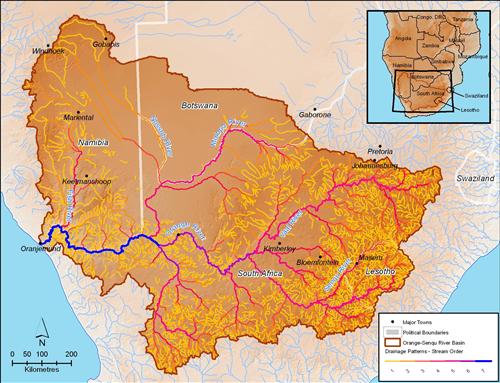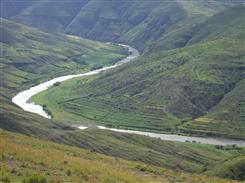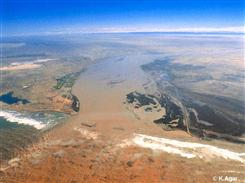Seen from above, river systems display a tree-like pattern, with many small streams feeding into fewer larger rivers and eventually into one very large river. Many systems have been developed to classify the different “levels” of streams in this pattern.
In the system devised by Strahler, each level of stream is assigned an order. Order 1 streams are the very smallest, uppermost streams (i.e., with no upstream tributaries). Two order 1 streams combine to form an Order 2 stream. Order 3 streams are formed from the confluence of two Order 2 streams. This way, higher-order streams are formed from the confluence of two lower-order streams; the watersheds of lower-order streams are included within the watersheds of higher-order streams. Orders 10–12 correspond to the main channels of large world rivers. Streams get wider and longer with increasing stream order.
Stream order of the Orange-Senqu River system is shown in the map below.

Stream Order of the Orange-Senqu River System.
Source:Hatfield 2009, after DWAF 2004
( click to enlarge )
Characteristics of a river system depend on the landscape, climate, other geographical features and natural processes in the region. Most river systems can be divided into different sections from the headwaters to the river mouth. The Orange-Senqu river system is divided into the Upper and Lower River Water Management Areas (WMA). The Upper Orange River includes the Orange–Senqu River in Lesotho and the Orange River in South Africa above the Vaal River confluence. The Lower Orange River includes the South African stretch below the Vaal River confluence, and the sections in Botswana and Namibia.
Upper River
The uppermost part of a river system includes the river headwaters and small, lower-order streams at higher elevation. The upper river basin is usually characterised by steep gradients and by erosion that carries sediments downstream. Streams in this upper region are usually steep and often include rapids and waterfalls. These streams generally have little floodplain, although part of the bank and surrounding land may be wetted during periods of high flow.
Lower River
The lower section of a river system (extending to the mouth) is usually flat, with a larger river channel and a lower gradient. In the middle portion of the river, there is a balance between erosion and deposition of sediment. Further downstream, mainly deposition occurs, while erosion occurs to a lesser extent. Along the Lower Orange-Senqu River, channel erosion and deposition are more episodic, responding to flows released from the dams in the Upper WMA.The main channel of the river meanders across the landscape unless they are artificially channelled.
 The Senqu River near its source. Source:Lesotho Water Commission 2003 ( click to enlarge ) |
 The Orange River Mouth. Source:Agar 1998 ( click to enlarge ) |
